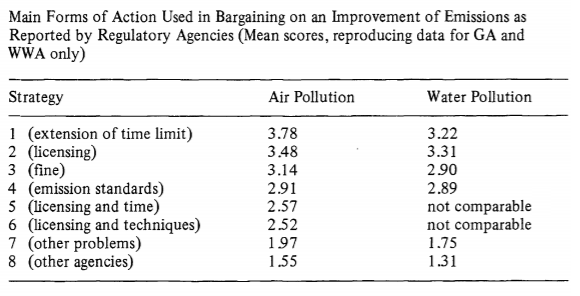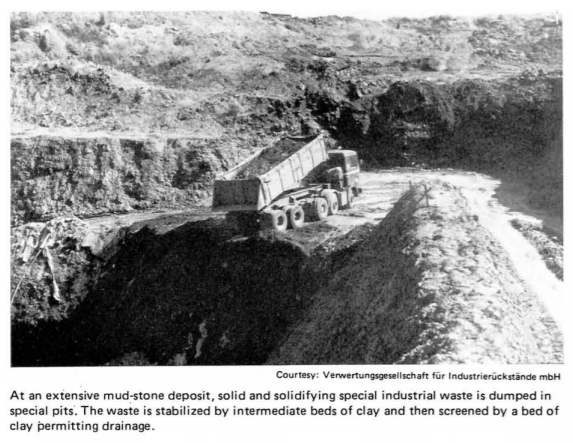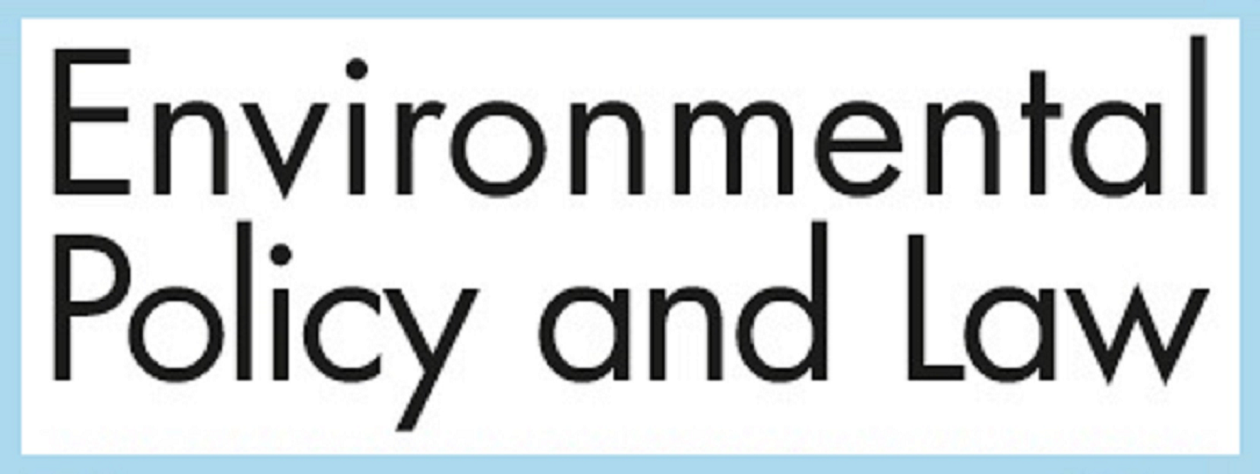Bargaining in Regulative Policy Implementation: The Case of Air and Water Pollution Control (Germany)
Jochen Hucke
Institute for Applied Social Research, Cologne, Germany
*Corresponding author
EPL, Vol.4, Iss.2-3, pp.109-115, 1978
Jochen Hucke
Institute for Applied Social Research, Cologne, Germany
*Corresponding author
EPL, Vol.4, Iss.2-3, pp.109-115, 1978
Introduction: Some Problems of Regulative Policy
Environmental policy in many fields consists of the classical type of regulative policy where administrative agencies have to implement legal norms by setting emission standards, controlling polluters, and sanctioning violations of givens stan· dards. Critics of regulative policy have argued that it will lead to an unequal treatment of the regulated subjects, as implementation will be done by bargaining, and not by a strict application of fixed decision rules to similar cases. They show that legal norms are formu· lated in a very abstract manner to cover a wide range of possible events. The expectation that the implementing agencies will 'fill in the details' oflegislation when they are applying the abstract norms seems to be an idealization, as agencies are confronted with the pres· sures ofinterests and power in the imple· mentation phase. This way the content of legislative regulation is formulated by discretionarily fixing the conditions of conduct in a process of interaction be· tween administrative agencies and the clientele of regulation.
To prevent administrative bargaining, that may lead to an overall distrust in government regulation because of its unequal results, critics have recommended to re·institute the legislative responsibility by setting 'clear standards of implementation' in the process of legislation. This idea may be an appealing one because of the fact that it would ideally cope with the problems of growing bureaucratization and social inequalities as a consequence of differential power bases in bargaining situations, but one has to ask if its premises are realistic. In its stress upon legislative fixation of decision rules the model implies that bureaucratic agencies will strictly execute the will of a legalized ruler without leaving the path of his prescriptions. Problems of regulative policy implementation may only occur here when there is some uncertainty in the ruler's instructions, which may be subject to a selective interpretation by the executing agency.
But in fact one must consider a second source for implementation problems in the regulatory policy type. These problems arise when the implementing agen· cies tend to ignore fixed legal decision rules though they are established in a relatively precise and detailed manner. That this problem is not an unrealistic one is shown by the case of regulative environmental policy in the Federal Republic of Germany. Here there is a body of detailed laws for the regulation of pollution problems, a well settled structure of enforcing organizations, whose organizational roots go back into the 19th century, and at least one might expect that the style of law enforcement in the Federal Republic would be strongly shaped by the authoritarian Prussian tradition of blind conduct, thus significantly differing from the American administrative system where the specific forms or personnel recruitment and free market-orientation would a priori back the tendency towards 'bureaucratic free enterprise' and bargaining with the clientele.
Instead, research proved that even German regulatory agencies are applying bargaining techniques in a broad manner, at least in the fields of air and water pollution control. This article will illustrate that bargaining is the result of specific conditions in the agency's implementation field often forming situations where the agency can no longer rely on the coercive power of its legal instruments and is forced to choose bargaining to secure a minimum of administrative success in the improvement of environmental quality. Bargaining situations and specific forms of bargaining strategies will be described. If it would be possible to generalize isolated findings for other sectors of law enforcement, one could extract a general statement on the central problem of regulative policy formulation and implementation in highly differantiated capitalist social systems: Whether regulative laws are set in an abstract or in a very concrete manner, a tendency will always exist towards bargaining in policy implementation. Bargaining, in turn, will lead to a discretionary treatment of the legal norms by favouring those of the clientele who have the better resources to comply in bargaining with the regulatory agencies. Assuming the above is correct, it would be better for social equality to establish regulative norms only in those fields of policy where the subjects' bargaining power is low in comparison to the agencies' power or where bargaining power is equally distributed between subjects. In policy sectors where these conditions are lacking an adequate solution could, perhaps, be found by using other legal instruments such as incentives, taxes, or collective problem-solving among the subjects of regulations.
Legislative Regulations in German Environmental Policy
As in most other sectors of the German federal political system, the legal norms for environmental policy are mainly formulated at the federal level (Bundestag, Bundesregierung) and implemented within the state governments (Bundeslander). The main norms for pollution problems covered by our research are the Federal Anti-Noise and Air Pollution Act (Bundesimmissionsschutzgesetz, abbreviated: BImSchG) from 1974 and the Water Resources Act (Wasserhaushaltsgesetz, abbr. WHG), which was considerably improved in 1976. Both laws are based on a longstanding tradition in legal regulations which have been steadily improved since the 1870s, when the fore-runner of the BImSchG, the Industrial Security Act (Gewerbeordnung), was formulated, and since 1900, when the first water resources laws came up.
The core of the BImSchG is a list of about 100 types of industrial plants which have to undergo a specific process of licenSing whereby a permitted quantity of pollution is fixed and methods of reducing pollution are determined. Only those plants can obtain a licence whose polluting effects lie below certain maximum standards for emissions generally laid down by law. A second condition for obtaining a licence is set by immission standards in which a degree of regional dispersion of air pollution is laid down which may not be exceeded by the additional polluting effect of the new plant.
Networks of Policy Implementation
Since the organizational design of the implementation structure falls into the field of the state governments' tasks, a great variety of organizational models are to be found. Fortunately, most of their differences lie in the details, so that we can generalize with regard to some fundamental patterns of implementation networks. In all states and in both environmental policy fields, planning and programming functions are concentrated at the state ministry level. Mostly, air and water protection tasks belong to the departments of two different ministries, water protection to the agricultural ministry, and air pollution problems to the ministry of health and labor security. Both ministries are supported by highly specialized central agencies that employ scientists and technicians to document the state of environmental quality for planning purposes and tci develop new techniques of emission reduction for the application in improvement procedures.
The six largest German states have divided it into regional units (Regierungsbezirke). Thus, there is another administrative level between the state and local administration representing all implementation tasks at the state level within a single agency. The role and function of this middle administrative agency is ambiguous. In fact it may differ from one field of policy implementation to another. One opinion suggests that the middle level will do no more than play the postman between ministries and local government, whilst another insists that the middle level agencies actively influence policy implementation at the local level. With regard to water and air pollution control, one may find that both opinions seem to be right for just one of the two sectors. In air pollution control a relatively small number of personnel is recruited from persons having administrative skills only, while in the water protection field there is a greater number of personnel with either administrative or technical skills. Thus in the field of air pollution control the middle administrative level will depend heavily upon information obtained from outside, in contrast to the water protection field where the staff will be better off generating and evaluating its own information.
Both middle level sectors have to fulfil similar functions. They have to supervise implementation at the lower level and to decide on licensing in the more important cases, the meaning of what is 'important' differing from state to state. Additionally, middle level agencies in water protection are more strongly involved in regional planning. At the local level there is a strict separation between technical and administrative skills, except in the case of air pollution control in Northrhine-Westphalia. The administrative part ofimplementation, such as writing the licences and collecting a fine is mainly done by the local city and county governments who employ people with administrative skills but who normally do not have any detailed technical knowledge concerning environmental policy. Those technical requirements are met by special state agencies responsible for one or more cities or counties within a region. Here we have industrial inspectorates (Gewerbeaufsichtsamter, abbreviated: GA) for air pollution control and water resources agencies (Wasserwirtschaftsiimter, abbr.: WWA), both mainly recruiting technicians.
Strategic Elements of Administrative Bargaining
To find out which strategies are mostly used to arrive at a bargaining solution, an attempt was made to formulate this question in a mailed questionnaire sent to all regulatory agencies in the air pollution field and to a sample of agencies engaged in water pollution control. The problem was that bargaining usually consists of a very complex cluster of single actions, formed by the situation, and the preferences and the differential of resources accessible to the actors, so that it is hardly possible to find bargaining processes that are identical over more than one event. But instead of comparing the whole process of bargaining, one should come close to the problem when asking what elements of actions or strategies are mostly used within a bargaining process.
In this way some typical forms of actions were singled out which had been reported to the researchers during the interview-phase of the research and were put in a standardized form usually consisting of a statement describing a specific form of improvement problem. The statements were supplemented by a five point scale reaching from 1 ('never used this form of action ') to 5 ('form of action very frequently used'). Strategies listed all follow the rule that the agency has to give away something that may be useful for the firm to get consensus on an improvement in return. This way the full impact of emission control as prescribed in the legal norms is reduced in the implementation phase.
One of the most common forms of action (strategy no.1) is an extension of the time limit the agency allows the firm to take with the improvement. Though it is not possible to specify the duration of those limits, it may take several years, and there is a chance that the case may be forgotten meanwhile. As an extreme example Gerd Winterl reports a case of water pollution control where 20 years passed until an improvement was reached. The strategy of delay is an interesting one for the firms not only because they can try bargaining once again when the time is over, but it also gives them the chance to distribute their expenditures or credits over a longer period, thus reducing financial burdens. A similar effect for the firm's cost structure can be reached when emission standards are not as restrictively formulated as they could be with respect to the technical development of emission control (strategy no.4). On the other hand this strategy helps to solve a problem for the agency, which often comes into difficulties when it has to give an exact definition of the best available technology.
The strategy of combining an improvement with a bonus in other fields the agency is responsible for (work security for instance, strategy no.7) is seldom used, as the gains in cost seem to be relatively small. From the firm's point of view a compensation in other policy fields (land-use planning for instance, strategy no.8) would be more attractive, but this will occur very rarely, as it requires difficult negotiations with the agency governing the policy field in which the firm is interested.


This includes only short extracts from the original article; view in full via the link below.
